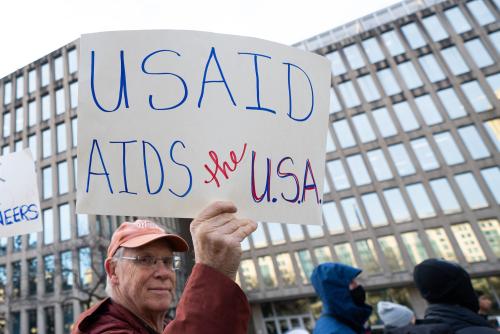Last week, world leaders agreed on an ambitious set of Sustainable Development Goals (SDGs) for 2030. Fully costed, the price tag for achieving these goals over the next 15 years will run into the trillions of dollar, however. The implication is that everyone in the world will have to contribute in one way or another—private businesses as well public sector agencies.
Volunteers seem to be the least recognized group of contributors, despite being the least-expensive component. They often play a crucial role in “the last mile” of program implementation. Volunteer service in support of the SDGs also enriches the lives of volunteers and helps to building the sense of global citizenship that is essential for global peace and well-being.
For the individuals involved, the core benefit of volunteer action comes from working outside of your culture. Making sandwiches for your children is not volunteer action. Making sandwiches at a shelter for the homeless is.
This concept of volunteer action, or service, was probably absent in primitive tribal communities and in early civilizations—such as Egypt—where slavery was embedded in the culture. It was certainly present, however, in the great religions that subsequently emerged and evolved, including Buddhism, Judaism, Christianity, and Islam. It is implicit in the messages that Pope Francis brought to the United States and the United Nations earlier this month.
Volunteer action took a great leap forward when President John F. Kennedy established the Peace Corps in 1961 for international service and President Lyndon B. Johnson created VISTA in 1965 for domestic service. The evolution since then has been interesting.
The Peace Corps grew quickly to almost 16,000 volunteers in the field in the mid-1960s, dropped to as low as 4,000 in the 1970s, and grew back slowly to around 8,000 in the early 1990s. It has been stuck at this level since then, despite campaign promises by Presidents Clinton, Bush, and Obama to double the number of serving volunteers.
Meanwhile, a bubbling universe of international volunteer programs emerged in the United States. University-sponsored, corporation-sponsored, NGO-sponsored, and for-profit programs are sending more than 50,000 Americans to foreign countries for short-term and long-term service every year. Inspired by the Peace Corps, other advanced countries also created their own international volunteer programs.
The evolution of government-supported volunteer programs domestically was quite different. In 1993, President Clinton established the Corporation for National and Community Service to manage a new AmeriCorps program along with VISTA and several other small pre-existing programs. AmeriCorps has grown rapidly to the point of having 75,000 volunteers today engaged in full-time, one-year service commitments. Officials from other countries—both advanced and developing—have also been coming here for 20 years to see how AmeriCorps works, before then starting similar domestic service programs in their countries.
Two forces are driving the volunteer movement globally. The first is budget constraints everywhere. In our modern societies, everybody wants to enjoy a good life, but we haven’t figured out how to get enough tax revenue to pay the teachers, health workers, engineers, and community organizers needed to achieve this happy outcome. We have, however, figured out how to mobilize volunteers to provide these services to the neediest.
The second force is an abstract concept combining civic duty and helping the less fortunate. As modern societies have become wealthier, this concept has become more powerful.
Two manifestations of these forces are especially relevant now.
The first is the role of volunteers that has been incorporated in the U.N. Sustainable Development Goals. Implementation is receiving more attention in the SDG process than it received in the preceding Millennium Development Goal process. The U.N has recognized that mobilizing volunteers effectively will be necessary to achieve every one of the SDGs. No government has a budget big enough to pay a living wage for all the hours of work that will be required to meet its own SDGs.
The other manifestation is a new debate in the United States about “national service.” Since the military draft was terminated in 1973, concern has slowly grown about having a military force that does not reflect the broad population. It is possible that the sense of national unity felt so strongly after World War II was related to the experience of so many men and women performing national service outside their culture. That kind of service was a social and civic glue that seems in short supply now.
The Aspen Institute’s “Franklin Project” aims to create a one-year national service commitment—either civilian or military—that becomes a valued part of growing up in America. It can help cure the divisiveness by taking us outside our culture and helping us appreciate others. It can be a better kind of glue.
Volunteer action across borders can also be a better kind of glue for the whole world.
SDGs) for 2030. Fully costed, the price tag for achieving these goals over the next 15 years will run into the trillions of dollar, however. The implication is that everyone in the world will have to contribute in one way or another—private businesses as well public sector agencies.
Volunteers seem to be the least recognized group of contributors, despite being the least-expensive component. They often play a crucial role in “the last mile” of program implementation. Volunteer service in support of the SDGs also enriches the lives of volunteers and helps to building the sense of global citizenship that is essential for global peace and well-being.
For the individuals involved, the core benefit of volunteer action comes from working outside of your culture. Making sandwiches for your children is not volunteer action. Making sandwiches at a shelter for the homeless is.
This concept of volunteer action, or service, was probably absent in primitive tribal communities and in early civilizations—such as Egypt—where slavery was embedded in the culture. It was certainly present, however, in the great religions that subsequently emerged and evolved, including Buddhism, Judaism, Christianity, and Islam. It is implicit in the messages that Pope Francis brought to the United States and the United Nations earlier this month.
Volunteer action took a great leap forward when President John F. Kennedy established the Peace Corps in 1961 for international service and President Lyndon B. Johnson created VISTA in 1965 for domestic service. The evolution since then has been interesting.
The Peace Corps grew quickly to almost 16,000 volunteers in the field in the mid-1960s, dropped to as low as 4,000 in the 1970s, and grew back slowly to around 8,000 in the early 1990s. It has been stuck at this level since then, despite campaign promises by Presidents Clinton, Bush, and Obama to double the number of serving volunteers.
Meanwhile, a bubbling universe of international volunteer programs emerged in the United States. University-sponsored, corporation-sponsored, NGO-sponsored, and for-profit programs are sending more than 50,000 Americans to foreign countries for short-term and long-term service every year. Inspired by the Peace Corps, other advanced countries also created their own international volunteer programs.
The evolution of government-supported volunteer programs domestically was quite different. In 1993, President Clinton established the Corporation for National and Community Service to manage a new AmeriCorps program along with VISTA and several other small pre-existing programs. AmeriCorps has grown rapidly to the point of having 75,000 volunteers today engaged in full-time, one-year service commitments. Officials from other countries—both advanced and developing—have also been coming here for 20 years to see how AmeriCorps works, before then starting similar domestic service programs in their countries.
Two forces are driving the volunteer movement globally. The first is budget constraints everywhere. In our modern societies, everybody wants to enjoy a good life, but we haven’t figured out how to get enough tax revenue to pay the teachers, health workers, engineers, and community organizers needed to achieve this happy outcome. We have, however, figured out how to mobilize volunteers to provide these services to the neediest.
The second force is an abstract concept combining civic duty and helping the less fortunate. As modern societies have become wealthier, this concept has become more powerful.
Two manifestations of these forces are especially relevant now.
The first is the role of volunteers that has been incorporated in the U.N. Sustainable Development Goals. Implementation is receiving more attention in the SDG process than it received in the preceding Millennium Development Goal process. The U.N has recognized that mobilizing volunteers effectively will be necessary to achieve every one of the SDGs. No government has a budget big enough to pay a living wage for all the hours of work that will be required to meet its own SDGs.
The other manifestation is a new debate in the United States about “national service.” Since the military draft was terminated in 1973, concern has slowly grown about having a military force that does not reflect the broad population. It is possible that the sense of national unity felt so strongly after World War II was related to the experience of so many men and women performing national service outside their culture. That kind of service was a social and civic glue that seems in short supply now.
The Aspen Institute’s “Franklin Project” aims to create a one-year national service commitment—either civilian or military—that becomes a valued part of growing up in America. It can help cure the divisiveness by taking us outside our culture and helping us appreciate others. It can be a better kind of glue.
Volunteer action across borders can also be a better kind of glue for the whole world.
The Brookings Institution is committed to quality, independence, and impact.
We are supported by a diverse array of funders. In line with our values and policies, each Brookings publication represents the sole views of its author(s).



Commentary
Sustainable development needs organized volunteers
September 30, 2015